On this page
- Research article
- Volume 45, Issue 2
- Pages: 13
- -22
- Open Access
- Download
Research on Business English Approaches from the Perspective of Cross-Cultural Communication Competence
- Published: 30/06/2024
Abstract
In the reform of teaching mode, the supply of large-scale teaching does not match the needs of students’ personalized training. In terms of teaching concept innovation, teaching practice can hardly catch up with the pace of theoretical innovation and the evolution of social market demand. Considering the increasingly common global communication, the digitalization and intelligence upgrade in the economic field, and the reform of the teaching paradigm driven by a new round of scientific and technological revolution, this paper discusses the necessity of reforming the teaching ideas and methods of flight attendant management from the perspective of cross-cultural communication competence. At the same time, this paper proposes that the actual teaching should be student-centered and market-oriented. Through the integration of virtual and reality, teachers and students can communicate with each other in both virtual and real dimensions. By accelerating the practice and reform of the teaching in this way, we can improve the cross-cultural communication ability of talents in the field of flight attendant management and cultivate high-quality talents more suitable for modern civil aviation business.
- Keywords: cross cultural communication, airline crew, virtual teaching, teaching reform approach
1. Introduction
The continuation of the COVID-19 pandemic has had a huge impact on domestic and foreign tourism and transportation industries, and the civil aviation industry has also been affected [1]. Under the current situation of coexistence of crisis and opportunity, it is extremely important to reserve relevant talents for flight crew management in the future [2]. In recent years, many higher vocational colleges in China have strengthened the construction of teaching systems related to aviation crew management, which better meets the development trend of the current aviation market and proves the strong demand for talents in aviation related industries [3]. In the process of airline operation and management, the diversified background of passengers puts forward higher requirements for the communication and scene adaptability of airline crew [4]. In addition, the international working environment and atmosphere of the aviation industry also requires employees to have certain cross-cultural communication skills, otherwise, communication barriers and impacts are easily caused in daily work [5]. Therefore, good cross-cultural communication ability is as important as the ability to learn and accept professional knowledge, which is the necessary ability for current flight crew management students to provide high-quality services for passengers from all over the world, cooperate with foreign colleagues, and promote themselves in the aviation industry[6,7]. This also puts forward higher requirements for the current teaching work in the field of aviation crew.
With the current global wave of digitalization and intelligence driving the in-depth development of a new round of scientific and technological revolution, the meta universe and virtual world, which integrate the advantages of a variety of emerging technologies, have burst into vigorous development potential, and mankind is gradually breaking through the boundaries of time and space to create a social development form in which virtual and reality are integrated, which will profoundly affect the reform and development of all walks of life, including education [8,9]. The evolution of modern universities in the past hundreds of years shows that new technology and new ideas are important factors to promote university reform. At present, the virtual world represented by the meta universe has entered the educational field and constantly triggered the innovation and development of teaching activities [10].
The educational meta universe has greatly expanded the space-time boundary of teaching and learning and promoted the reform of teaching concepts and models. Experimental data show that the education meta universe supported by key technologies can effectively improve the cognitive input of learners [11]. The virtual world provides a new practical field for university teaching innovation and leads the new trend of university teaching paradigm change [12]. In the future, we should transform, and upgrade Universities Based on the needs of national development, integrate virtual teaching into real teaching as a breakthrough, promote the transformation and development of the cultivation mode of senior talents in the aviation field, actively innovate the teaching paradigm of traditional universities, and help universities achieve leapfrog development in the new era.
2. Related works
Cross cultural communication ability and civil aviation cabin culture (see Figure 1).

The research on cross-cultural communication originated in North America. Chinese scholars began to study cross-cultural communication in the 1980s [13]. Most of the early research dimensions were foreign languages and teaching Chinese as a foreign language. In recent years, Chinese scholars have made rich research results on cross-cultural communication from the perspective of sociology and psychology. [14] It is believed that cross-cultural communication can be defined as the communication between people of different nationalities and cultural backgrounds. Therefore, cross-cultural communication also exists among people of the same nationality. [15] It is believed that the ability of cross-cultural communication includes communication, flexibility in dealing with cultural differences in the process of cross-cultural communication, tolerance for cultural differences and sensitivity to cultural shocks. Chinese airline flight attendants must understand the differences between Chinese and foreign cultures, thinking logic and values, to know themselves and the other, avoid conflicts and collisions with tourists and colleagues due to cultural differences in their daily work, meet complex challenges, and integrate into the diversified family of the international aviation industry faster and better [16].
As an important travel tool, aviation brings together tourists with different needs and employees of different nationalities, and multiple cultures coexist simultaneously through tangible and intangible modes. Therefore, to cultivate high-quality flight attendants who meet the needs of the future aviation industry and meet international aviation standards, cross-cultural communication ability should be one of the key modules of the professional talent training program. See Table.1, Table.2 and Table.3
| Serial Number | Name | Proportion |
|---|---|---|
| 1 | Sichuan University | 7.54% |
| 2 | Shandong Normal University | 5.39% |
| 3 | Yunnan Normal University | 5.39% |
| 4 | Beijing Normal University | 5.39% |
| 5 | Other | 76.32% |
| Serial Number | Number of Signatures | Number | Author |
|---|---|---|---|
| 1 | 5 | 1 | Xiaochun Zhang |
| 2 | 4 | 1 | Du Fief |
| 3 | 3 | 1 | Liu Ling |
| 4 | 2 | 1 | Xiao He |
| 5 | 2 | 1 | Qing Liu |
| Serial Number | Frequency | Centrality | Key Word |
|---|---|---|---|
| 1 | 58 | 1.07 | Chinese International Education |
| 2 | 57 | 0.86 | Cross-Cultural Communication |
| 3 | 20 | 0.46 | Cross Cultural Communication Ability |
| 4 | 6 | 0.02 | Cultural Difference |
| 5 | 7 | 0.05 | Master of Chinese International Education |
3. Methods
College students lack the real scene of cross-cultural communication, and sometimes it is basically impossible to create practical opportunities for real cultural communication and cultural communication, resulting in difficult realization and guarantee of teaching results; In addition, cultural communication has high requirements for personnel participation, and it is not feasible for students and teachers to practice one-on-one, so it is difficult to track the learning effect and learning situation analysis. Based on the above two situations, we can design an immersive virtual experimental classroom for cross-cultural communication and conduct scene simulation exercises for cultural communication.
Necessity of virtual teaching research, as shown in Figure 2.

The traditional classroom teaching content focuses on theoretical learning, which cannot be timely combined with cross-cultural communication information in the network era, and students cannot quickly convert and apply the newly acquired cultural knowledge and skills into practice; Traditional classroom teaching methods cannot give students a sense of immersion in their surroundings. Students have very few practical opportunities for cultural exchange and communication, and they cannot fully mobilize students’ visual, auditory, and kinesthetic senses, stimulate students’ interest in learning, and improve learning efficiency; The traditional course evaluation method is mainly a teacher teaching and evaluating students in a class. It is not feasible for students and teachers to practice one-on-one, so it is difficult to track the learning effect and learning situation analysis.
Therefore, the basic principle of designing a virtual teaching environment is to use virtual technology to create a highly realistic language input and output situation of immersive cross-cultural communication, integrate the above three factors affecting cultural teaching and practical training, form a knowledge system composed of typical Chinese and Western cultural comparison units with multiple scenes and themes, and build a practical intelligent teaching and communication service system based on cross-cultural communication. We use story situations to carry out human-computer dialogue, distance teaching and other practical training methods under different themes, and carry out skills training such as logical combing ability, use ability of cultural words and expression ability of Chinese and Western cultural exchanges in simulated situations and even real situations, to comprehensively improve students’ cultural communication skills in real situations.
4. Importance of Virtual Teaching
The high simulation, interactive and full participation simulation scenario organically combines the forms of picture prompts, text guidance and animation display, changes the single way of teaching and learning in the past, which was dominated by hearing, vividly displays cultural knowledge points to students, and can fully mobilize students’ enthusiasm for learning. In addition, the virtual operating environment is like the online games that students usually contact. It needs to break through and upgrade, and gradually complete the experimental tasks in depth. This requires students to carefully review cultural knowledge points, master cultural communication points, and avoid cultural taboos, to complete learning indicators and carry out effective cultural communication and dissemination. The victory experience and pleasure feeling after successfully completing the experimental steps are also the driving force to promote students’ learning. Virtual classroom emphasizes experimental teaching content, attaches importance to the understanding and mastery of cultural knowledge, adheres to problem orientation, and emphasizes quality over quantity. In combination with the needs of social development for talent cultivation in colleges and universities, we should first meet the teaching objectives and requirements of our cross-cultural communication courses, and then create a cultural exchange platform and cultural communication carrier that can be shared by other colleges and universities. This will pave the way for students engaged in the aviation crew management industry to exchange Chinese and Western cultures, so that they can have stronger competitiveness, market adaptability, and quickly integrate into the working scene of cross-cultural communication in their actual employment. Virtual experimental classroom emphasizes the research and development of technology for teaching objectives and learning situation analysis.
It comprehensively uses big data, multimedia, three-dimensional modeling, human-computer interaction, virtual reality, and other networked, digital, and intelligent technical means to improve teaching effectiveness, and makes up for the fatal deficiency that cross-cultural communication experiments in the real world cost a lot and cannot be widely realized. The teaching effect is remarkable, and the benefits are large. It can effectively and quickly test the learning effect of students, accurately and comprehensively provide correct real-time feedback results, and is the basis of real and reliable teaching and scientific research. In the teaching process, teachers and even industry elders can identify cultural knowledge points based on their own years of education or work practice, which can reduce students’ blindness and confusion in the process of cultural exchange. In addition, the guiding role of teachers is also reflected in the design of experimental projects. For example, it pays attention to protecting the security of students’ information, the smoothness of human-computer interaction, and the effective mode of the sustainability of experimental projects. It also uses rich teaching experience and scientific research experience to preset various situations that may occur in experiments, guide students to turn what they have learned into what they can use and continue to explore in the correct experimental steps.
5. Progressiveness of Virtual Teaching
| Words | Culture Background | Meaning |
|---|---|---|
| Siren | The Odyssey | Alarming |
| Candidate | Candirus (Latin) | Man in white robe |
| Cancel | Canceller (French) | delete |
| First-rate | A-1 ship | No. 1 |
| Schedule | Sc he da (papyrus leaf) | Small piece of paper |
| Slogan | Gaelic | battle cry |
| Journey | Diu r num (Latin) | One da yes distance |
| Jet-propelled | Jest (French) | Throw away |
| Etiquette | Etiquette (French) | Ticket |
| Crisis | Kris is (Greek) | Turning point of illness |
Table.4 is reflected in the design ideas of teaching. It takes virtual social life as the scene, human-computer interaction, and oral communication as the means of investigation, examines students’ ability to logically sort out and make cultural judgments in a short time, and their ability to reasonably deal with cultural conflicts, as well as their ability to master cultural knowledge points and cultural expression. It realizes the real-life practice of cross-cultural communication that could not be realized in the past, and fundamentally solves the malpractice of one-to-one practice and assessment that students and teachers can not all carry out, which has high requirements for personnel participation. It really starts from the needs of students. It not only pays attention to the teaching of cultural knowledge and the cultivation of communicative ability, but also pays attention to helping students establish a sense of social responsibility, cultural consciousness, and cultural self-confidence. Under the background of Chinese culture going out, the virtual course of cultural communication has a broad space for expansion. The humanistic spirit it carries is also an important part of the new liberal arts construction. Secondly, from the perspective of innovation of experimental teaching methods, the task-based teaching method, which mainly focuses on the cognitive process of second language teaching, is adopted.
The teaching adopts the project modular teaching mode, creates a vivid learning experience, and effectively helps teachers and students set and achieve the goals of cultural learning and communicative competence training. The project uses VR technology to restore the real situation of cross-cultural communication and make students feel immersive. Thirdly, the virtual experiment of cross-cultural courses breaks through the limitations of traditional teaching in terms of teaching content and means.
6. Teaching Reform of Air Crew Management
China’s aviation industry is in the process of rapid start-up and development. China’s aviation industry is also facing the impact of China’s huge population. China’s aviation industry has a broad market. Therefore, in this process, the whole industry must improve its service quality and service level, to better cope with the development situation in the new era and new trends. This also puts forward higher requirements for our flight crew management teaching.
The change of flight attendant service career comes from the sky because the talents cultivated by aviation schools and aviation vocational colleges in China are constantly expanding and expanding. In this process, the original scarce resources have become more than scarce. In the traditional aviation industry, there are only a few colleges and universities in the country that can train the talents of aviation service personnel, However, with the development of modern education and the continuous improvement of the level of aviation industry, many higher vocational colleges can also train corresponding talents. Therefore, the career of flight attendant has gradually become popular. In the process of modernization, many higher vocational colleges can constantly and stably export corresponding flight attendant management and service personnel to the society. Therefore, this post is also constantly facing the impact of new talents. In the process of the new talent impact, there will be competition among industries. At this time, the flight attendant service industry will face stronger competition in this process. Competitors need to abandon some of their own time and arrangements to constantly adapt to the development of aviation, they also need to show enthusiasm in their work before they can be retained. This element makes the aviation crew management profession competitive in the development process of this new era. The highly competitive environment makes the shortcomings in teaching infinitely magnified in the trained talents. In this process, the competitiveness is weakened, so it cannot adapt to the development trend of the profession.
7. Experiment
A. Design of Virtual Teaching Platform
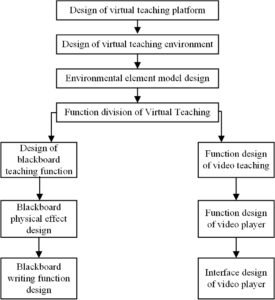
As shown in Figure 3 Online virtual teaching is a new teaching mode based on virtual reality technology for education and learning in virtual space. It enables teachers and students to complete the whole process of teaching and learning in the virtual environment by constructing a virtual teaching and learning environment, and then objectively and truly simulating and reproducing knowledge points. The whole process requires corresponding adjustments in teaching philosophy, teaching learning relationship, teaching organization and teaching means. For this reason, this paper takes the actual teaching environment as the virtual teaching environment through offline on-the-spot investigation, which is composed of environmental elements such as walls, floors, doors, blackboards, lectern, tables, chairs, windows, curtains, fans, and chandeliers. According to the characteristics of students’ curiosity, strong learning ability and active thinking, combined with the characteristics of VR technology, we designed and developed a set of simple online virtual teaching platform suitable for contemporary college students, trying to inject interesting VR teaching functions into the boring teaching method of traditional written “filling the classroom and making students listen”, so that observation learning, experience learning and practical operation learning can enter the classroom, Stimulate their interest in learning. The main functional modules of the virtual teaching platform include the design of virtual teaching environment and its element model, the division of virtual teaching functions, and the teaching functions are further divided into blackboard teaching functions and video teaching functions.
According to the functional module planning, we need to design each module one by one, and realize the design of the main environment and related elements in the traditional teaching mode, the teaching blackboard function design, and the video playback function design in the virtual teaching environment. In this paper, the high-precision 3D model and high-resolution material of 3dsmax modeling software are used, and the dynamic lighting effect created by the lighting system of Unreal Engine 4 is used to build a realistic virtual teaching environment.
B. Element model design of virtual teaching environment
Table model design. The overall length is 66cm, the width is 44cm and the height is 75cm. The drawer is 55cm long, 33cm wide and 18cm high. In terms of material, the wooden tabletop, metal table legs and drawers are restored, and the visual effect is shown in Figure 4.
Chair model design. The overall length is 41 cm, the width is 36 cm, the height is 74 cm, the height of the cushion is 40 cm, and the height of the backrest is 34 cm. In terms of material, the wooden cushion and backrest are restored, and the metal frame is used. The visual effect is shown in Figure 4.

Figure 4: Table chair model Fan model design. The overall radius is 70cm and the height is 46cm. The fan rotation can be simulated by touching the interactive switch. The material is restored to metal, and the visual effect is shown in Figure 5.
Model design of chandelier. The overall length is 122 cm, the height is 64 cm, and the light diameter is 2 cm. Combined with the lighting system, the real lighting effect can be simulated. The material is restored to a metal bracket and a bright white bulb. The visual effect is shown in Figure 5.
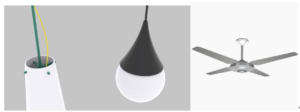
Figure 5: Ceiling lamp and ceiling fan model Fan model design. Curtain model design. The overall length is 224 cm and the height is 255 cm. In terms of material, the metal bracket and cloth curtain are restored, and the visual effect is shown in Figure 5. Doors and windows are shown in Figure 6, and their parameters are omitted and will not be described in detail.

Figure 6: Door and window model Blackboard model design. The overall length is 404 cm, the height is 164 cm, and the thickness is 15 cm. It is divided into four sub blackboards and a white board. A single sub blackboard is 100 cm long, 154 cm high, and 4 cm thick. The white board is 190 cm long and 154 cm high. The two sub blackboards in the middle are movable. The metal frame and green board surface are restored on the material, and the visual effect is shown in Figure 7.
Platform model design. The overall length is 110 cm, the width is 74 cm, and the height is 100 cm. The material is restored to metal, and the visual effect is shown in Figure 7.

Figure 7: Blackboard and lectern model Classroom model design. The whole is 9 meters long, 6.9 meters wide and 3.4 meters high. It is composed of simple cubic walls, floors and ceilings. After integrating the above environmental element models, the effects are shown in Figure 8 from the front and rear perspectives.

C. Dynamic interactive element design of Virtual Teaching
Function design of blackboard writing elements. It includes control objects, chalk, and blackboard. Among them, the control object is the avatar of the user in the virtual scene and the main body of the VR online teaching mode. All interactive functions need to be realized around the control object. The user manipulates the control object through the VR handle to perform all interactive behaviors. The motion controller pawn of the control object is responsible for the basic operations of the user, simple user interaction operations and user mobile operations; Chalk implements it as an interactive blueprint class based on its 3D model, so that users can hold it in their hands; The interactive function of the blackboard is to realize its teaching function. Combined with the previous two parts, it realizes its mobile function and writing function. The user controls the embedded blackboard to drag it left and right through the handle, and the user holds chalk to write on the blackboard.
Blackboard moving function design. By detecting whether the user’s hand contacts the blackboard and pressing the pickup interactive button, if the above conditions are met, the coordinates of the user’s hand will be tracked, and the blackboard to be interacted will be subjected to coordinate tracking transformation. When the user’s hand contacts the blackboard, the blackboard moving operation will be ended. Part of the blue chart code is shown in Figure 9.

Figure 9: Blackboard moving blueprint code Writing function design. By detecting whether the user’s hand holds the chalk and whether the chalk contacts the blackboard, if the above conditions are met, the absolute coordinates of the chalk are tracked, the relative coordinates are obtained by coordinate conversion with the absolute coordinates of the blackboard currently in contact, and then the canvas implemented by the widget component cooperates with a self-defined drawing function to connect the front and rear relative coordinates of the frame into a line within the frame interval and draw them on the canvas for rendering, To achieve the effect of writing on the blackboard, when the chalk held by the user ends the contact with the blackboard, the writing operation is ended. Part of the blueprint code is shown in Figure 10.
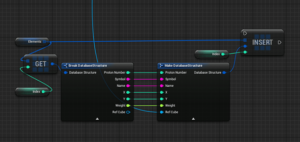
Figure 10: Blackboard writing blueprint code Video teaching function design. It includes a controller and a video player. The controller needs to add a control interaction component on the original basis to interact with the video player. The video player is implemented by inheriting the editor tool controls. Like common players, it has basic video switching, speed change, play pause, progress adjustment and volume adjustment functions. Its interface is shown in Figure 11.

While teachers play videos, students can also synchronize videos played by teachers on their own video players to achieve the best video teaching effect. The virtual teaching scenario we coded and implemented is shown in Figure 12 .Both figures simulate the teacher explaining geometric models such as cubes, cuboids, and spheres to students, but the observation angles are different.
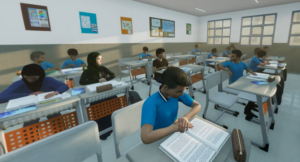
From the figure, we can see that students can intuitively understand the structural characteristics of these geometric models. In addition, the 3D display function of VR objects can also be used to display more complex biological and mechanical structures, which can describe the objects shown more comprehensively and in detail, so that students can understand their three-dimensional structures and motion modes more quickly and accurately. Figure 13 is the scene after students (leading display) access the online virtual teaching platform through the terminal.
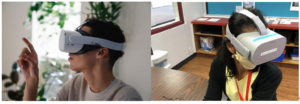
The topology of the platform is shown in Figure 14, including student side, teacher side, web server and database server. Data transmission and storage are conducted through VR devices (head display) and network devices. Both teachers and students can log in to the VR teaching platform through the terminal. Teachers and students need to take the lead in the whole class process, otherwise they cannot see the virtual scene.

8. Conclusion
With the continuous advancement of cross-border cooperation, the increasing number of international passengers in the cabin service has increased the demand for cross-cultural communication skills in the profession of flight attendants. While satisfying students’ instrumental motivation, we should also strengthen the connotation of human nature, so as to cultivate high-quality talents with international vision and cross-cultural communication ability. The limitations of the existing teaching methods have become increasingly prominent. We should continue to carry out targeted technical reform and introduce virtual teaching methods. The combination of reality and virtual environment will strengthen students’ adaptability to the actual situation and meet the learning needs of multicultural knowledge. These teaching reforms can reduce teaching costs and enhance the competitive advantage of talents in the job market, promote the construction of an industrial cycle and help students gain more real experience.
References
- Mai LT. Intercultural competence as an important attribute for the graduates in the context of globalisation: the case of young Vietnamese working for INGOs. Intercultural Education. 2021 Sep 3;32(5):562-77.
- Xu Y, Tao Y, Zhang C, Xie M, Li W, Tai J. Review of digital economy research in China: a framework analysis based on bibliometrics. Computational Intelligence and Neuroscience. 2022;2022(1):2427034.
- Zhussupova RF, Beisembayeva ZA. Modeling online grouping for developing intercultural communicative competence of pre-service teachers at university. Cross-Cultural Studies: Education and Science. 2021(1):112-26.
- Stefanic I, Campbell RK, Russ JS, Stefanic E. Evaluation of a blended learning approach for cross-cultural entrepreneurial education. Innovations in education and teaching international. 2020 Mar 3;57(2):242-54.
- Xue E, Li J. Top-down education policy on the inclusion of ethnic minority population in China: A perspective of policy analysis. Educational Philosophy and Theory. 2020 Feb 23;52(3):227-39.
- Nguyen HL, Luong DH, Hoang PH, Almonte-Acosta SA, Umali EG, Puertoc JN, Le AV. The Transversal Competencies of Vietnamese Primary Students and the Relationship with Online Learning Activities during the COVID-19 Pandemic. International Electronic Journal of Elementary Education. 2022 Jun;14(5):667-78.
- Mohammed SH, Kinyó L. The cross-cultural validation of the technology-enhanced social constructivist learning environment questionnaire in the Iraqi Kurdistan Region. Research and Practice in Technology Enhanced Learning. 2022 Jun 21;17(1):25.
- Shonfeld M, Cotnam-Kappel M, Judge M, Ng CY, Ntebutse JG, Williamson-Leadley S, Yildiz MN. Learning in digital environments: a model for cross-cultural alignment. Educational Technology Research and Development. 2021 Aug 1:1-20.
- Nomnian S, Trupp A, Niyomthong W, Tangcharoensathaporn P, Charoenkongka A. Language and community-based tourism use, needs, dependency, and limitations. Austrian Journal of South-East Asian Studies. 2020 Jun 29;13(1):57-79.
- Louhapensang C, Noobanjong K. Cultivations of cross-cultural experiences via a collaborative and cooperative approach for sustainable learning from communities in Si Satchanalai, Thailand. Cogent Education. 2021 Jan 1;8(1):2003959.
- Qiu L, Qi L. E-learning assessment for tourism education LISREL assisted intercultural tourism perception and data integrated satisfaction perspectives. Journal of Computing in Higher Education. 2020 Apr;32(1):89-108.
- Arden C, Okoko JM. Exploring Cross-Cultural Perspectives of Teacher Leadership among the Members of an International Research Team: A Phenomenographic Study. Research in Educational Administration \& Leadership. 2021 Mar;6(1):51-90.
- Chen J. Research on the application of project-based teaching reform of professional English course under the cross border e-commerce platform. Advances in Vocational and Technical Education. 2021 Sep 24;3(2):159-62.
- Li J. The Construction and Implementation of a Compound Foreign Language Talent Training Model. Journal of Contemporary Educational Research. 2022 Jul 28;6(7):99-106.
- Pun J. The priorities, challenges, and scope of clinical communication teaching perceived by clinicians from different disciplines: a Hong Kong case study. BMC Primary Care. 2022 Jun 22;23(1):158.
- Slapac A. Advancing students’ global competency through English language learning in Romania: an exploratory qualitative case study of four English language teachers. Journal of Research in Childhood Education. 2021 Apr 3;35(2):231-47.